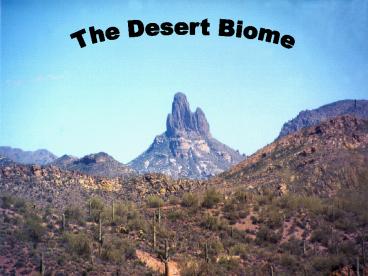The Desert Biome - PowerPoint PPT Presentation
1 / 11
Title: The Desert Biome
1
The Desert Biome
2
What Does This Biome Look Like?
Deserts have a very limited variety of plants.
The most common types of plants in the desert are
the succulents. Succulents are plants that store
water in their enlarged fleshy leaves, stems,
and/or roots. Succulent plants are adapted to
store water for longer periods of time.
Some examples of plants that live in the desert
are cacti, Joshua trees, palm trees, sagebrush,
and yuccas. Most deserts have little life, and
most animal life that can be found in the desert
is only active at night. This is because there
is nothing in the desert to sustain heat during
periods of nighttime.
3
Climatograph
4
Location of the Desert Biome
Natural Boundaries They are found on the leeward
side of mountains where a rain shadow is created
because as the clouds move up the mountains they
lose their moisture. Once they reach the other
side of the mountain they evaporate moisture from
the soil. Other desert areas are made because the
prevailing winds are too far from bodies of
water. Global Distribution There are two major
belts of deserts, one along the tropic of
Capricorn, and the other along the tropic of
Cancer. Most deserts are between 30 degrees north
and 30 degrees south of the equator.
5
Seasonal Summary
The spring season is short only February and
March, while the summer stretches from April to
the middle of September. Fall ranges from the
middle of September to November, and winter is
from December to January. In the spring there is
the highest average rainfall and moderate
temperatures around 20 degrees. During the
summer, the average rainfall falls to around 0 mm
and the temperature rises to around 30 degrees.
The Fall is the same as the summer, but the
temperatures gradually fall to the twenties.
During the winter the temperature falls to around
15 degrees, and there may be a small amount of
rainfall.
6
Wildlife in the Desert
Running Birds Running birds require very little
water to survive. Animals included in this group
are the ostrich and the roadrunner.
General Mammals These animals depend on
permanent water holes. Animals included in this
group are antelope, goats, sheep, and camels.
7
Wildlife in the Desert
Desert Rodents Desert Rodents live mostly
underground during the day, surfacing for food
only at night. They can survive drinking no water
at all, deriving all they need from the
metabolism of their food. Animals included in
this group are bats, gerbils, rats, and rabbits.
Reptiles Reptiles also live underground during
the day, and surface at night to feed with the
mammals. Some reptiles such as the horned toad
can control their metabolic heat production by
controlling their heartbeat and rate of body
metabolism. Some animals in this category are
lizards, horned toads, and snakes.
8
Wildlife in the Desert
Insects When it rains, dormant insect eggs and
pupae spawn crickets, grasshoppers, bees, wasps,
beetles, moths, butterflies, and ants, such as
this honeypot ant (left).
Plants Desert plants have evolved ways of
conserving and efficiently using water available
to them. Flowering plants usually live for only a
day or so their seeds lie dormant in the sand
until it rains. These are called
ephemerals. Woody desert plants have long root
systems that reach deep water sources.
Photosynthesis is done in the stems instead of
the leaves in some plants.
9
Human Impact
Desert lands are used for farming. Such use of
desert lands contribute to the accumulation of
salt on surface soil, eventually rendering it
useless. People mine the water reservoirs deep
beneath the desert. This water is irreplaceable.
Also, burning and overgrazing the lands bordering
the desert damages the plants, enabling the
deserts to encroach on arable land. This process
is called desertification.
10
Future of the Desert Biome
The United Nations declared that the desert could
cover 35 of the earths surface because of
desertification. Poor farming could lead to the
loss of desert species, some of which are already
endangered.
11
Bibliography
http//encarta.msn.com www.wikipedia.com www.geog.
umn.edu






























